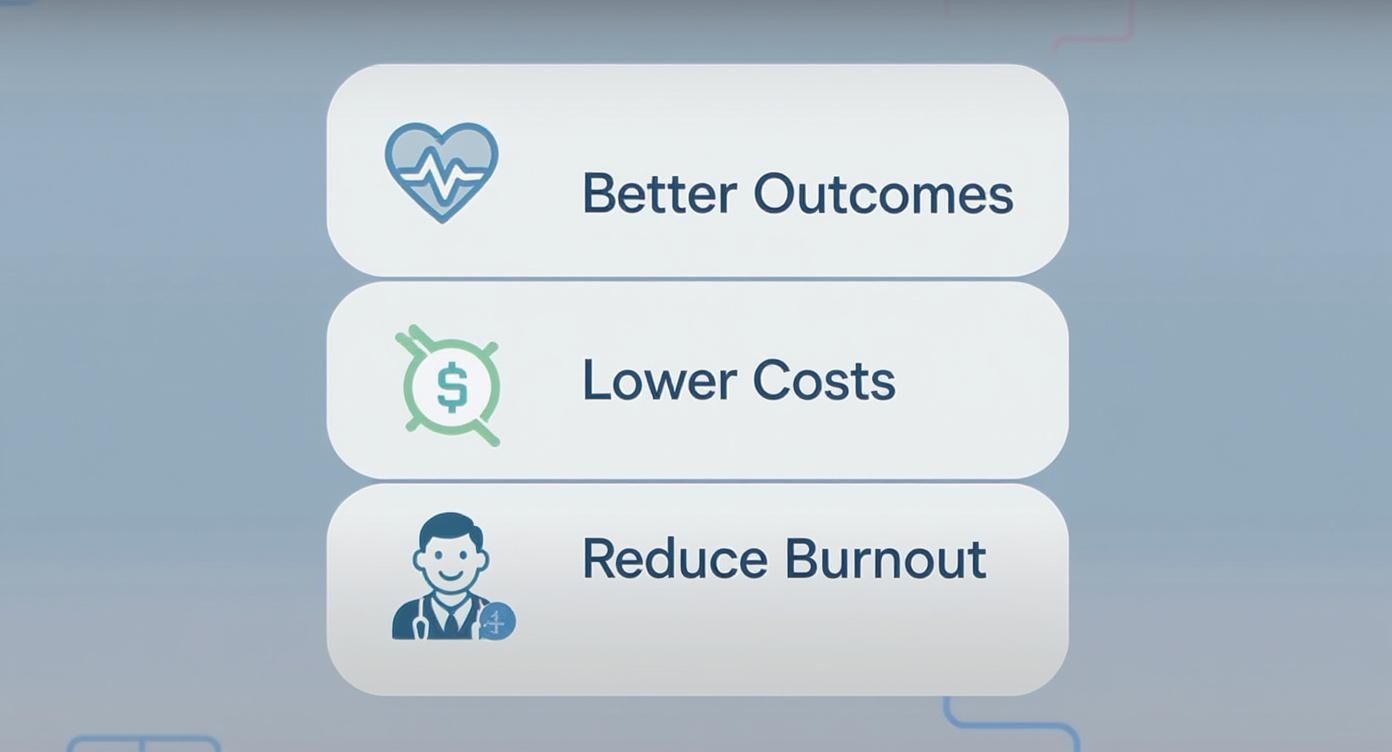AI in Healthcare Industry: Your Guide to the Future
The healthcare industry is going through a massive shift, with artificial intelligence at the very heart of it. This isn’t some far-off sci-fi concept; it’s happening today. From sharpening diagnostic accuracy to customizing patient care, AI is quickly becoming a go-to tool for both doctors and the teams that support them.
How AI Is Reshaping Modern Healthcare
Think of Artificial Intelligence (AI) less as a replacement for doctors and more as a highly skilled co-pilot. Machine learning models and sophisticated algorithms are now powerful partners, helping clinicians sift through enormous amounts of data to make quicker, more confident decisions. This change isn’t happening in a vacuum—it’s a direct response to urgent needs, like getting a handle on rising operational costs and easing the incredible strain of clinician burnout.
The real “why” behind this tech movement is straightforward. Healthcare systems are under immense pressure to deliver better results more efficiently. AI provides a clear path forward by automating tedious tasks, flagging at-risk patients earlier, and finding crucial patterns hidden deep within medical data. To get the full picture of how AI is helping in the healthcare industry, it’s helpful to see how its various applications are making a real-world impact.
The Driving Forces Behind AI Adoption
Several key factors are pushing AI into the mainstream of healthcare workflows. These aren’t just buzzwords; they represent real value for both providers and the patients they serve.
- Demand for Better Outcomes: AI algorithms can spot patterns in medical scans and patient records that the human eye might miss, which can lead to earlier, more precise diagnoses.
- Need for Operational Efficiency: Administrative work, from scheduling appointments to handling medical billing, eats up a lot of time and money. AI-driven automation lets staff step away from paperwork and focus on patient care.
- Rising Clinician Burnout: New tools, like ambient clinical intelligence, can listen to and automatically document conversations between doctors and patients, slashing the administrative burden that leads to burnout.
By taking over the repetitive, data-intensive tasks, AI gives medical professionals back their most valuable resource: time. This allows them to focus on direct patient interaction, complex problem-solving, and delivering compassionate care—the very things that technology can’t replicate.
Ultimately, the goal is to build a healthcare system that is more predictive, preventative, and personal. For any organization looking to make this leap, understanding the strategic benefits of AI for your business is the critical first step. It’s a journey that demands a clear vision and a reliable partner to turn technological promise into real improvements in patient outcomes and operational strength. This fundamental change is setting the stage for a new era in medicine, one where data-backed insights support human expertise at every turn.
The Unstoppable Growth of AI Adoption
The talk about AI in the healthcare industry has officially moved from “what if” to “what’s next.” We’re not just seeing a slow, steady climb in adoption; it’s an explosive surge, pulling in major investment and completely changing how the market works. This acceleration shows a real, growing trust in AI’s power to tackle some of healthcare’s oldest, most stubborn problems.
The evidence for this growth is hard to ignore. The healthcare industry, a massive $4.9 trillion sector, is now jumping into AI with both feet. According to research from Menlo Ventures, 22% of healthcare organizations are already using domain-specific AI tools in 2025. That’s a staggering 7-fold increase from 2024 and a 10-fold leap from 2023—an adoption rate more than double that of the wider economy. To get the full picture, you can read the full research about AI in healthcare .
Who Is Leading the AI Charge?
This wave of adoption isn’t happening everywhere at once. Certain players are moving faster. Large health systems are clearly out in front, with 27% having already rolled out AI solutions. Right behind them are outpatient providers at 18% and payers at 14%. This tells us that AI is being woven into the fabric of the entire healthcare journey, from the biggest hospitals to local clinics and insurance providers.
The infographic below breaks down the main reasons behind this industry-wide push.

As you can see, the motivation isn’t just about cool new tech. It’s tied directly to the core goals of healthcare: giving patients better outcomes, getting a handle on costs, and supporting overworked staff.
The Economic Engine Behind the Trend
Putting the practical benefits aside for a moment, the money flowing into this space tells its own story. The AI in healthcare market is no longer a niche for a few tech enthusiasts; it’s a major economic force that’s shaping global health. This rapid expansion is paving the way for fresh innovation and investment, cementing AI as a core piece of modern medical infrastructure.
The powerful financial currents driving AI adoption forward are undeniable. This is no longer just a tech trend but a fundamental economic shift in how healthcare is delivered and managed globally.
For any organization trying to ride this data-driven wave, the trick is turning these market numbers into a real strategy. This is where powerful business intelligence services become essential, helping to decode complex industry data and spot opportunities others miss. As a seasoned AI solutions partner, we guide organizations through this changing landscape, turning market potential into measurable success. The sheer scale and speed of this growth make one thing clear: AI isn’t just coming to healthcare—it’s already here, and its footprint is getting bigger every day.
Real-World AI Applications Transforming Patient Care
The real value of AI in healthcare isn’t just about market forecasts; it’s about what’s happening on the front lines of medicine right now. AI has moved beyond a buzzword and become a practical tool that supports clinicians, supercharges research, and untangles complicated hospital workflows every single day.
Think of AI as a powerful pattern-recognition engine. It can sift through enormous, complex datasets—from medical scans and DNA sequences to a patient’s entire health record—at a speed no human could ever match. The goal isn’t to replace doctors but to give them deeper, more accurate insights to work with.

AI in Medical Diagnostics
Medical imaging is one of the clearest examples of AI making a difference. Deep learning models are trained on millions of scans, teaching them to spot subtle signs of disease that are easy for the human eye to miss.
- Oncology: AI algorithms are getting incredibly good at analyzing mammograms and CT scans to find tumors earlier and more accurately. They act like a pre-screening assistant, flagging suspicious spots for a radiologist’s final review.
- Radiology: In a busy hospital, AI can be a lifesaver. It automatically scans images as they come in and prioritizes urgent cases—like a brain bleed or a clot in the lung—so the patients who need help now get it faster.
- Pathology: AI-powered microscopes can analyze tissue samples to identify cancerous cells and even help grade tumors. This gives pathologists a powerful analytical partner, making their work more precise.
Essentially, this technology works like a second set of expert eyes, helping to reduce diagnostic errors and letting specialists focus on the most complex cases.
Personalized Treatment and Drug Discovery
Beyond finding disease, AI is changing how we treat it. By analyzing a person’s genetics, lifestyle, and past medical history, AI can start to predict how they might respond to different drugs or therapies. This is a huge leap from the old one-size-fits-all approach toward truly personalized medicine.
It’s also shaking up the pharmaceutical world. Drug discovery is a notoriously long and expensive process, often taking more than a decade and costing billions. AI is changing that equation.
AI can analyze complex biological data to identify promising drug candidates, predict their effectiveness, and even design new molecules from scratch. This shortens research cycles and brings life-saving medications to market faster.
To get a sense of how AI is being applied across the board, here’s a quick summary of its core functions in different healthcare domains.
Core AI Applications Across Healthcare Domains
A summary of how AI is being applied in different areas of the healthcare industry to improve outcomes and efficiency.
| Healthcare Domain | Primary AI Application | Key Benefit |
|---|---|---|
| Diagnostics & Imaging | Analyzing medical scans (X-rays, CTs, MRIs) to detect anomalies like tumors or fractures. | Improved accuracy and earlier detection of diseases. |
| Drug Discovery | Identifying potential drug compounds and predicting their efficacy. | Faster research cycles and reduced R&D costs. |
| Personalized Medicine | Predicting patient responses to treatments based on genetic and clinical data. | More effective, tailored therapies with fewer side effects. |
| Hospital Operations | Optimizing patient flow, managing staff schedules, and predicting supply needs. | Increased efficiency, reduced wait times, and lower operational costs. |
| Clinical Documentation | Automatically transcribing doctor-patient conversations into EHR notes. | Reduced administrative burden and less clinician burnout. |
As you can see, the applications are incredibly varied, touching nearly every corner of the patient journey and the systems that support it.
Streamlining Hospital Operations
The clinical side is only half the story. AI is also making a huge dent in the administrative and operational challenges that drive up costs and lead to staff burnout.
- Administrative Automation: AI is taking over repetitive but necessary tasks like medical coding and billing, which means fewer errors and more time for staff to handle patient-facing issues.
- Patient Flow Optimization: Predictive tools can now forecast things like ER wait times or how many patients will be admitted on a given day. This helps hospitals manage their beds and staff much more effectively.
- Supply Chain Management: Instead of guessing, AI helps hospitals optimize their inventory of medical supplies. This ensures critical items are always on hand without wasting money on overstock.
One of the most exciting developments is something called “ambient scribe” technology. These AI tools listen in on a doctor-patient conversation and automatically generate the clinical notes for the electronic health record (EHR). This alone can save doctors hours of paperwork each day, directly fighting clinician burnout.
For a concrete look at how these ideas come to life, our work on an MDT planning app for a healthcare client shows how we build tools to support complex clinical decisions. You can see how we put these principles into practice by checking out our client cases.
A Look at the Global AI in Healthcare Market
If we pull back from the individual applications and look at the big picture, the global market for AI in healthcare isn’t just growing—it’s exploding. We’re witnessing a massive financial shift driven by huge investments and a real hunger for this technology. AI in medicine is no longer a niche idea; it’s quickly becoming a fundamental part of the healthcare economy.
The numbers here are genuinely eye-popping. The global artificial intelligence in healthcare market is on track to leap from $29.01 billion in 2024 to an astonishing $504.17 billion by 2032. That’s a compound annual growth rate (CAGR) of 44.0%, a clear signal of intense and lasting expansion. You can find more details on these market projections here.
Why North America Is Setting the Pace
Right now, North America is the clear frontrunner, holding a massive 49.29% market share in 2024. A few key ingredients are behind this lead:
- Rock-Solid Healthcare Infrastructure: The region’s advanced hospitals, research centers, and established digital health networks create the perfect environment for AI to take root and grow.
- Eager to Adopt New Tech: There’s a strong, built-in willingness across the board to embrace new technologies, from electronic health records to the latest diagnostic software.
- Heavy R&D Spending: Billions are poured into research and development from both government and private sources, which keeps the innovation engine running hot.
This powerful mix of infrastructure, investment, and a forward-looking attitude has put North America in the driver’s seat. As a leading AI solutions partner, we help organizations worldwide learn from this success, applying proven strategies to build their own powerful solutions.
The Players Shaping the Market
The field is a fascinating blend of tech titans and scrappy, focused startups. Big-name corporations are using their immense resources to build out large-scale AI platforms for things like EHR management and massive data analysis. Their existing strength in cloud services and business intelligence services gives them a natural edge in wrangling the huge datasets that healthcare AI depends on.
Meanwhile, specialized startups are making serious headway by zeroing in on specific, high-value problems. These nimble companies are behind some incredible innovations, like AI-guided surgical monitoring, precision cancer treatment platforms, and tools that predict disease before it strikes. They can move fast and often redefine what’s even possible.
You’ve got this healthy tension between scale and specialization. The tech giants lay the groundwork and provide the infrastructure, but it’s often the startups that deliver the most disruptive clinical breakthroughs. It creates a really vibrant, fast-moving ecosystem.
This dynamic pushes the entire field forward. Whether it’s developing smarter electronic health records or designing complex diagnostic algorithms, the demand for solid custom software development is greater than ever. Building these tools requires a real understanding of both the tech and the unique pressures of the medical world—a combination that sits at the core of our healthcare software development practice.
For any organization looking to jump in or grow its presence, the opportunities are massive. Whether that means launching a new SaaS product or weaving AI into an existing workflow, expert SaaS Consulting and top-tier AI development services are critical for success. As our client cases show, having a clear plan and the right technology partner can make all the difference in a field moving this quickly.
Navigating the Challenges of AI Implementation
For all the incredible potential of AI in healthcare, the journey from concept to clinic is anything but simple. Getting these powerful tools into the hands of doctors and nurses means confronting a thorny mix of technical, ethical, and regulatory roadblocks. It’s not a plug-and-play situation; succeeding requires a clear-eyed view of the very real hurdles ahead.

Successfully weaving AI into the fabric of healthcare demands that we tackle these issues head-on. The stakes—patient safety, data security, and the trust of clinicians—are simply too high to do otherwise.
Ensuring Data Privacy and Security
The engine of any AI model runs on data. In healthcare, that data is some of the most sensitive information imaginable. Protecting it isn’t just a good idea; it’s a legal and ethical imperative, enforced by strict rules like HIPAA.
- Staying HIPAA Compliant: Any AI system touching patient data must be built from the ground up with compliance in mind. This means every piece of information must be handled, stored, and processed according to strict protocols, often relying on secure cloud services built for healthcare.
- Managing Cybersecurity Risks: As AI becomes more connected, it creates new doors for potential cyberattacks. We have to bolt those doors shut. Robust security isn’t optional—it’s the only way to prevent breaches that could expose confidential patient records.
A rock-solid data governance framework is the only way forward. You have to define exactly who can access data, how it can be used, and how it’s protected every step of the way.
Mitigating Algorithmic Bias
Here’s a hard truth: an AI is only as good as the data it’s trained on. If that data carries the baggage of existing societal or healthcare biases, the AI will not only learn those biases but can actually amplify them. This can create dangerous inequities in care.
Think about it: an AI diagnostic tool trained mostly on data from one demographic might stumble when analyzing a patient from a completely different background. This is a massive risk, and it’s why model fairness has to be a top priority.
The so-called “black box” problem—where you can’t see how an AI reached its conclusion—is a non-starter in medicine. Doctors, nurses, and patients need to trust that an AI’s output is fair, equitable, and based on solid reasoning, not some hidden prejudice baked into the code.
It’s on us to demand transparency from AI vendors and constantly audit these algorithms for bias. This is how we ensure AI becomes a tool for health equity, not a barrier to it.
Overcoming Regulatory and Integration Hurdles
Bringing a new AI-powered tool into a hospital involves more than just great code. It means navigating a labyrinth of regulatory approvals and messy technical integrations. If the AI is part of a physical tool, for example, you have to grapple with the complex FDA approval process for medical devices.
Even after clearing regulatory hurdles, there’s the practical challenge of making the new tech talk to the old. Many hospitals run on legacy IT systems that weren’t designed to play nicely with modern AI platforms. Bridging that gap requires serious engineering skill to avoid disrupting the critical work happening every day.
Ultimately, the human element is just as crucial. Doctors and nurses won’t use a tool they don’t trust or understand. They need to see AI as a helpful partner, not a mysterious replacement. That trust is built through smart training and thoughtful change management. Partnering with seasoned AI development services experts from the beginning helps ensure these tools are built for the people who will actually use them.
What Does the Future Hold for AI in Healthcare?
Even with all the progress we’re seeing, the current applications of AI are just scratching the surface. What’s coming next is a fundamental shift in how we approach medicine itself—moving away from a system that primarily treats sickness to one that actively predicts and prevents it. We’re talking about a future that is more proactive, intensely personal, and remarkably efficient.

Several emerging trends are driving this change. Generative AI, for example, won’t just be used for scribing notes. It will soon power empathetic, intelligent chatbots that can give patients guidance and support around the clock. At the same time, predictive analytics will expand beyond hospital logistics to manage the health of entire populations, spotting at-risk communities and allowing for interventions before a crisis hits.
The Rise of Proactive and Connected Care
One of the most exciting developments on the horizon is the combination of AI with the Internet of Things (IoT). Think about it: wearable sensors that constantly track a patient’s vitals from the comfort of their home. An AI system could analyze that stream of data in real-time, catching tiny deviations that might signal a brewing health issue long before the person even feels sick.
This blend of AI and connected devices fundamentally changes the game. Healthcare stops being a reactive practice and becomes a proactive partnership between patient and provider. This evolution is powered by specialized IoT software development services that build the secure, smart networks needed for effective remote monitoring.
The financial world is betting big on this future. The U.S. market alone, valued at an estimated $13.26 billion in 2024, is expected to explode to $221.09 billion by 2033. That kind of investment underscores the massive demand for smarter, more accessible healthcare. Discover more insights about the U.S. AI in healthcare market.
The future isn’t about replacing clinicians but about creating a connected ecosystem where AI acts as a constant, vigilant partner. This system anticipates needs, personalizes interventions, and keeps people healthier outside the hospital walls.
Turning Future Possibilities into Current Realities
Making these future scenarios a reality takes more than just cool technology. It requires a clear strategy and a deep understanding of the healthcare field. For organizations, waiting to adopt these tools is no longer an option—it’s a necessity for staying relevant and providing the best possible care.
Embarking on this journey means finding an experienced AI solutions partner with a proven track record. By looking at our client cases, you can see firsthand how we turn ambitious concepts into practical, real-world results. Bringing AI for your business to life is about choosing a team that gets both the technical potential and the human side of medicine.
From foundational healthcare software development to sophisticated AI development services, the right expertise is what bridges the gap between the promise of tomorrow and the reality of today.
Frequently Asked Questions About AI in Healthcare
1. How is AI actually being used in hospitals today?
AI is already active in many clinical and administrative areas. In diagnostics, it helps radiologists analyze medical images like X-rays and CT scans to detect diseases earlier and more accurately. Operationally, it automates scheduling and medical billing, freeing up staff to focus on patient care. AI also supports personalized medicine by analyzing patient data to predict treatment responses and powers “ambient scribe” tools that automatically document doctor-patient conversations, reducing clinician burnout.
2. What are the biggest hurdles to implementing AI in healthcare?
The primary challenges include ensuring robust data privacy and security to comply with regulations like HIPAA, mitigating algorithmic bias to ensure fair and equitable outcomes for all patient demographics, and integrating new AI systems with legacy hospital IT infrastructure. Overcoming these hurdles requires careful planning, transparent processes, and building trust among clinicians and patients through effective training and change management.
3. Will AI replace doctors and nurses?
No, AI is not set to replace healthcare professionals. Instead, it serves as a powerful assistive tool or “co-pilot.” It excels at data-heavy, repetitive tasks, allowing doctors and nurses to dedicate more time to complex decision-making, patient interaction, and the compassionate aspects of care that require human empathy and judgment.
4. How can a healthcare organization get started with AI?
The best approach is to start small with a clear, strategic goal. Identify a specific, high-impact problem—such as reducing diagnostic errors in a particular area or automating a burdensome administrative task. A successful pilot project builds momentum and demonstrates value. Before starting, ensure you have high-quality, organized data, which is the foundation of any successful AI initiative. Partnering with experienced ai development services can provide the necessary expertise to guide this process, as we explored in our AI adoption guide, a thoughtful, step-by-step approach is crucial for success.
Ready to explore how AI can transform your healthcare operations? Bridge Global is your expert AI solutions partner, offering everything from custom software development to specialized business intelligence services. Let’s discuss how to bring the power of AI to your organization.


